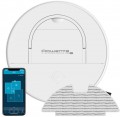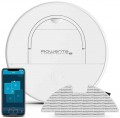Additional functions provided in the design of the robot vacuum cleaner (see "Type").
Most often in modern robots you can find such special functions:
scheduled cleaning,
fall protection,
obstacle sensor,
object recognition,
water supply adjustment,
control via the Internet,
remote control and
video surveillance camera. Here is a more detailed description of each of them:
- Scheduled cleaning. The ability to set a schedule according to which the vacuum cleaner will clean automatically, without additional commands from the customer. At the same time, the specific features of such programming may be different, they should be specified separately. So, in the simplest models, the schedule is limited to individual hours within a day - for example, from 16 to 17; at the set hours, the vacuum cleaner is switched on every day. More advanced devices may provide a schedule for the days of the week or even for the dates of the month or year. In any case, this function greatly simplifies the use: it is enough to set the schedule once - and you can not worry about cleaning for at least a few days; especially since most models with this capability also have the function
of docking...(see “Robot Configuration - Charging Station”), and the customer only needs to periodically empty the dust container (which is even more simplified if there is a docking station with a bag - see . below).
- Fall protection. Special protection that prevents the vacuum cleaner from falling off steps, high thresholds, etc. In most cases, the basis of such a system is one or more sensors located on the underside of the case. When the vacuum cleaner travels to the edge of the surface being treated, the sensor reacts to this edge - as a result, the device stops and changes direction in order to avoid falling.
- Obstacle sensor. Sensor (or sensor system) for detecting obstacles in the path of the vacuum cleaner. The specific type of such sensors can be different: ultrasonic, infrared, laser, contact, etc. However, in any case, this function allows the device to move in space, avoiding collisions and determining the best detour path. Note that models without such a sensor, for the most part, are also able to bypass obstacles - however, for this, the robot must not only stumble upon a foreign object, but try to pass through it. And only in case of failure, the trajectory changes - moreover, randomly, far from always in the optimal (or at least suitable) direction.
- Object recognition. The function of recognizing various objects on the floor that may interfere with the cleaning process. It is implemented through the presence of a front camera to adjust the optimal route for the vacuum cleaner along the perimeter of the serviced area. The camera in the design of the robotic cleaner reads the outlines of objects and allows you to bypass such obstacles. As a result, slippers, socks thrown under the bed, children's's toys and wires will no longer interfere with the movements of the vacuum cleaner. The function is of particular benefit in the presence of pets at home that are not accustomed to the tray - the robot will calmly has their waste products and keep the nervous system of pet owners healthy.
— Adjustment of water supply. Dosing system for the degree of wetting of the washing cloth in automatic mode. The ability to select the intensity of the water supply allows you to adjust the operation of the robotic vacuum cleaner for different types of floor coverings. For example, for parquet and laminate, the customer can set a low water flow rate, and for less whimsical tiled flooring, a high water flow rate. Also, the vacuum cleaner can turn off the water supply to avoid leaks, for example, when charging. In advanced models of robotic vacuum cleaners, the function of choosing an individual degree of wetting of the napkin for each of the rooms of the dwelling is often incorporated.
— Docking station with a bag. Docking station with its own trash bag. Upon arrival at such a stand, the robot can not only recharge the battery, but also carry out self-cleaning - unload the collected garbage into an external container; The capacity of the dock, as a rule, is enough for several unloadings. The convenience of this function is obvious: it allows the device to work longer without customer intervention, eliminates the need to manually clean the vacuum cleaner when the dust container is full (besides, unloading garbage from the dock is usually easier than such cleaning). True, and such opportunities are quite expensive.
- Management from the Internet. The ability to control the vacuum cleaner via the Internet - most often through a special application on a smartphone or other gadget (theoretically, such control is also possible through a web page that opens in any browser, but in practice this method is almost never used). The robot itself is connected to the network via Wi-Fi. The main advantage of this function is obvious - it allows you to give commands to the device from anywhere in the world where there is Internet access. In this way, for example, you can start a cleaning programme the day before you return from vacation in order to return to a freshly cleaned apartment. And the vacuum cleaner, in turn, can send various notifications to the customer - about the state of the battery, the progress of cleaning, the fullness of the dust container, etc.
- Remote control. A classic remote control that allows you to give commands to the device from a distance. As a rule, such a remote control covers all the main functions of the vacuum cleaner, and in many models it also allows you to directly control the movement. In any case, without remote access, it would be very difficult to control a moving vacuum cleaner - you would either have to wait until it finishes working, or catch the unit on the go. In light of this, this feature is very popular; however, on sale you can find a lot of robots without a remote control. As a rule, these are either the simplest budget devices with a random movement mode and without any additional functions, or advanced models where a smartphone / tablet with an application is used for control.
We also note that the remote controls in robotic vacuum cleaners usually work via an infrared channel - similar to remote controls for TVs, air conditioners, etc. Thus, to receive a command, the vacuum cleaner must be in the line of sight. However, in most cases this can not be called a serious inconvenience.
- Videcam. Own surveillance camera built right into the vacuum cleaner. This feature is only found on web-based models (see above); it allows you to use the robot as a remote video surveillance system and control the situation in the room, being outside and watching the picture from the camera on the smartphone screen. Also, the built-in camera can be used in the mapping system (see "Building a room map") - however, we note that not every vacuum cleaner with a built-in mapping camera has a video surveillance function.
